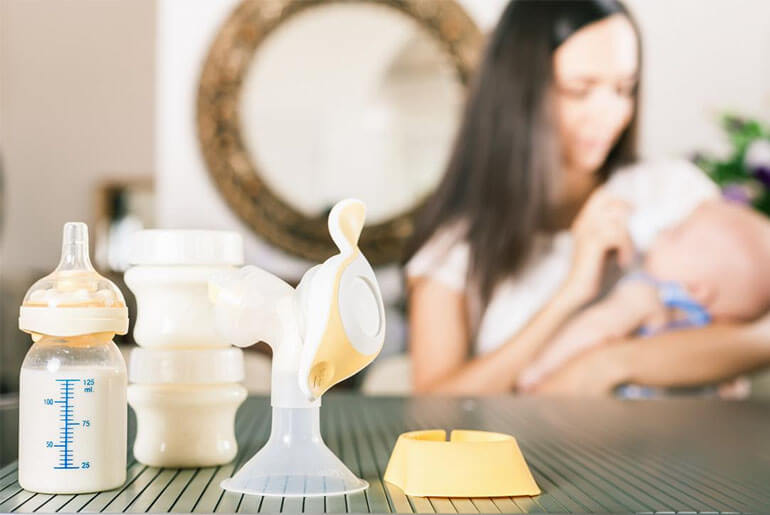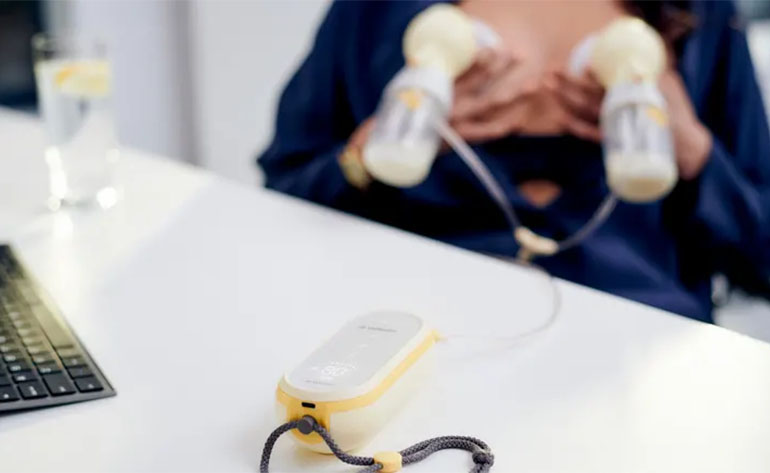Disclaimer: There are affiliate links in this post. At no cost to you, I get commissions for purchases made through these links.
Being a breastfeeding mom is challenging. It can be more complicated when going back to work during this period. It’s better to find out an effective way to make breast milk, set up a pumping routine while at work, and come back to your home in time to feed your baby.
Don’t get stressed. This article will recommend some sample breastfeeding and pumping schedules for working moms.
Let’s dive into it and build a suitable one for yourself!
How Often Should You Pump At Work?
It’s hard to find the exact answer to any question regarding parenting. In general, you can pump milk after every 3 or 4 hours at work. The exact times depend on several factors. It would be best if you thought about the following aspects:
1. The Baby’s Age
The baby’s age is one aspect that will determine how frequently you should pump milk. For instance, if your child is younger than a three-month-old, you should pump more frequently than when your baby is older.
It would help if you fed younger newborns eight times per 24 hours at the absolute least. An older baby is likely to begin eating solid foods. After he begins the food, he may require less milk.
Your body becomes accustomed to your employment and pumping routine. The feeding frequency will gradually reduce when your newborn grows older. Your milk production should have established itself by then, and you might extend among sessions. So, you might not have to pump your milk as much during the working time.
2. The Working Time
Moms who work as freelancers or part-time jobs will feel easier to balance breastfeeding and working.
Some women try to cram as much work as they can into their days. Some people combine working from home and working in the office. This way allows them to build a schedule that accommodates both their company’s and their newborn’s demands.
Most breastfeeding women try to include 2 or 3 intervals into their 8-hour working time. Typically, a few of these occurs during lunch. If you breastfeed your baby fully before leaving him for others and quickly after you get home, you can lessen the amount of frequency.
You can consider your pumping session depending on your working time, such as:
- The workday of hours: 1 session
- The workday of 6 hours: 2 sessions
- The workday of 8 hours: 3 sessions
- The workday of 12 hours: 4 sessions
3. Milk Supply
You need to ensure you have healthy breast milk and regulate your milk production if you’ve been after birth for over 12 weeks.
Your hormones can’t drive milk supply, which is now more dependent on demand and supply. You will make more milk if you suck more regularly. So, if you’re accustomed to nursing your newborn every three hours when you’re at work, you should stick to that routine.
If your breast milk supply is low, you’ll need to pump more often during your workday to increase it.
If your milk supply is abundant, you should reduce your pumping frequency. However, when your milk outcome begins to dwindle, take action to remedy the situation.
Your milk production will become more steady if you stay at home with your infant as much as possible.

How Long Is A Good Pumping Session While At Work?
The frequency determines how long you should spend each session while at work.
If you’re pumping following the recommended frequency of sessions above, each should last between 15 to 20 minutes. In most cases, 15 minutes is sufficient, although some mothers may require additional duration to drain their breasts.
The sessions might be a little longer if you’re sucking less regularly, either as your baby grows up or you can’t because of your job schedule. If possible, strive for 40 to 60 minutes of total duration during an eight-hour shift.
If you intend to pump twice, each session can last 20 to 25 minutes. If you do this task once, you can perform longer, approximately 40 minutes. This long of a session isn’t always possible, so do your best.
Furthermore, if your working shift is slightly shorter or longer, you can adjust your duration to match your absence from home.
How Much Milk Will You Need Each Day?
You should produce your breast milk as much as the infant consumes, if not more. Based on your child’s appetite and age, most care professionals, daycares, or nannies may suggest one more mealtime than he needs.
Depending on your child’s age and the amount he consumes, the exact quantity of ounces may vary. But, you have to produce sufficient breast milk to last your infant a whole day.
Suppose your infant requires at least 4 to 5 ounces every 3 hours, 2, for example. It’s better to aim for 5 to 7 ounces per session, or even more than 9 ounces!
The most straightforward approach is to leave your pump working about 5 minutes after your breast milk has stopped flowing. This way, you can reach your optimal production level.
When you require more, the body may deliver more. With all those pumping and much breast milk, you have an edge in extracting the baby food. Each session can provide you with an additional 2 to 5 ounces of milk, which is ideal for steadily increasing your freezer stockpile.
Some moms assume this amount is not enough for their babies. Don’t worry!
You pump breast milk at work daily. After your first day, you will pump for the next day again. This cycle goes on every day.
Also, you will send your previously pumped milk to the care provider or the nanny. Ensure your milk is enough for the first day, and you’ll be ok.

Sample Pumping and Nursing Schedule for Working Mom
If you try to find the best pumping schedule when back to work, these samples below will help!
Pumping Schedule At Work For 3-Month-Old
2 – 3 times throughout your workday are reasonable for a 3-month-old baby. A baby at this stage should only drink formula or breast milk. You’ll need to pump regularly enough to keep up with your child’s milk supply.
It’s best to pump before 1 hour you go to work, and after 1 hour, you get home. You can pump three times throughout your workday: at 10 am, your lunchtime, and 3 pm.
In other words, you’ll pump or nurse after three hours or so. This method will aid in the preservation of your milk production.
You can consider the following sample:
- 7 am: Pump/Nurse before your shift (in about 15 to 20 minutes)
- 10 am: Pump break (in about 15 to 20 minutes)
- 12 pm: Lunch Break (in about 30 minutes)
- 3 pm: Pump Break (in about 15 to 20 minutes)
- 6 pm: Pump/Nurse (in about 15 to 20 minutes)
It’s better to pump while working, which saves your time. If you feel difficult to pump very often, you may need the help of a hands-free breast pump.
Pumping Schedule At Work For 6-Month-Old
If you have a 6-month-old baby, you can pump milk after every 4 hours. So, if you have an 8-hour workday, you should pump twice. Remember to pump before 1 hour you go to your office, and after 1 hour you arrive home.
Moreover, you can extract twice during your workday, at 11 am and 3 pm. It means that each session will last roughly 4 hours. Thus, you can keep your milk production going for this long.
Do you notice your milk supply decreases, and you may not have enough to meet your child’s needs?
Don’t worry! You can either return to your previous pumping routine or augment it with formula.
- 7 am: Pump/Nurse before your shift (in about 15 to 20 minutes)
- 11 am: Pump Break (in about 30 minutes)
- 3 pm: Pump Break (in about 15 to 20 minutes)
- 6 pm: Pump/Nurse (in about 15 to 20 minutes)
Pumping Schedule At Work For 9-Month-Old
If your baby is nine months old, it’s a good idea to maintain every 4-hour session during your workday. You can stick to the plan if you’re only producing enough milk to cover your baby’s daily needs.
If you find your daily pumped breast milk is more abundant than what the baby can consume, it’s better to adjust your schedule – pumping less frequently.
When your child grows nearly one year old, you won’t need to stockpile milk in the freezer.
You can take a glance at this sample schedule:
- 7 am: Pump/Nurse before your shift (in about 15 to 20 minutes)
- 11 am: Pump Break (in about 30 minutes)
- 3 pm: Pump Break (in about 15 to 20 minutes)
- 6 pm: Pump/Nurse (in about 15 to 20 minutes)

Pumping Schedule For 8-Hour shift
If you work an 8-hour shift without seeing your child, you’ll probably have to pump breast milk twice.
- 7 am: Pump/Nurse before your shift (in about 15 to 20 minutes)
- 10 am: Pump Break (in about 30 minutes)
- 1 pm: Pump Break (in about 15 to 20 minutes)
- 4 pm: Pump/Nurse (in about 15 to 20 minutes)
Pumping Schedule For 12-Hour shift
Do you work in a hectic profession and take up a shift within 12 hours, such as a nurse? Establishing a schedule can be pretty tricky.
Some mothers extract their milk after every three hours, while others only do so once or twice after every 12 hours. Some women extract whenever their baby consumes, while others suck when comfortable.
Pumping at least three times throughout 12 hours, or roughly every three or four hours, is a great idea, as the following schedule:
- 6 am: Pump/Nurse your shift
- 7 am: Work
- 10 am: Pump Break
- 12 pm: Pump Break
- 4 pm: Pump Break
- 7 pm: Get Home
- 8 pm: Pump/Nurse at home
If you follow this schedule, you need to perform three times during your workday.
If a long session is not feasible, you should try to extract about 10 to 15 minutes instead of skipping your schedule.
FAQs
Does Pumping Count As A Break?
The short answer is yes! According to the Patient Protection and Affordable Care Act, employers must give adequate break time for a woman to extract milk for her breastfeeding baby.
Can I Go 12 Hours Without Pumping?
The storage capacity of each breast is different. So, you can go 10 or even 12 hours without pumping. However, be careful. The longer the interval between pumping, the slower the milk production. In addition, engorgement can lead to clogged milk ducts or, even worse, mastitis and abscesses that will require medical intervention in the hospital. So please limit this.
Is It Better To Pump Longer Or More Frequently?
If you have a lot of trouble producing breast milk, it’s better to pump more often instead of pumping longer. Each pumping session should last only 20-30 minutes, and you can extend it 1-2 minutes after the last drop. However, pumping for longer than 30 minutes can lead to sore nipples and other problems. You can also apply Cluster Pumping or pumping while driving to increase milk supply effectively.
In A Nutshell
This article has shown you some samples of breastfeeding and pumping schedule for a working mom. If you are a new mother, there won’t be the best pumping schedule, but create the most suitable one.
With a specific nursing schedule, you can balance your workload and breastfeeding when you are going back to work.
Hopefully, this article will be helpful for you. If you have any further questions, feel free to comment below.



